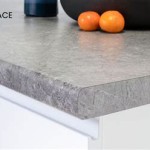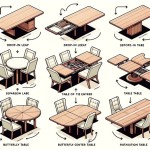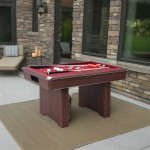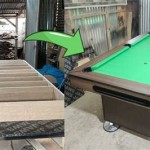Side Tables Made of Books: A Literary Furniture Statement
The creation of side tables from stacked books represents a unique intersection of function and artistry. It transforms everyday reading materials into a structural component of interior design. This approach offers a sustainable and personalized way to furnish a living space while explicitly demonstrating a love for literature. The following article will explore the key considerations in constructing and styling a side table made of books, discussing practical advice as well as aesthetic considerations.
Choosing the Right Books: Structure and Stability
The foundation of any successful book side table lies in the selection of appropriate books. The primary consideration centers on structural integrity. Hardcover books are virtually mandatory; paperbacks lack the necessary rigidity to support weight and maintain a stable form. Ideally, the books should be of a similar size and thickness to promote an even distribution of weight and minimize wobbling. Variations in size can be compensated for, to a certain degree, with careful arrangement, but consistency is preferable.
The physical condition of the books also plays a critical role. Books with significantly damaged spines, detached covers, or heavily warped pages are not suitable. These imperfections compromise the structural integrity of the overall stack and can lead to eventual collapse. Consider selecting books that are in good to very good condition, even if they are not aesthetically matched. The visual appeal can be addressed separately.
The quantity of books needed depends directly on the desired height of the side table. Standard side tables typically range from 20 to 24 inches in height. Measure the thickness of the chosen books and calculate the number required to reach this height. It is prudent to slightly overestimate, as a slightly taller table can be easily accommodated, while a shorter one may lack adequate surface space. The weight of the books collectively will also contribute to the table's stability; a heavier table is generally more resistant to accidental tipping.
Consider the internal structure of the books. Some older books, particularly those bound before the mid-20th century, may be sewn together using relatively weak threads. These books, while aesthetically appealing, may be more prone to spine separation under constant pressure. Newer books, with more robust adhesive bindings, often offer superior structural support. If opting for older books, inspect the spines carefully for signs of weakness or damage. A professional bookbinder can often reinforce the spine, but this adds to the overall cost of the project.
Beyond structural considerations, consider the paper quality. Acidic paper, common in many older books, can deteriorate over time, leading to brittleness and discoloration. While this may not immediately impact the structural integrity of the table, it can lead to the release of dust and debris, requiring more frequent cleaning. Archival-quality paper, found in more recent publications, is less prone to this type of degradation.
Another often overlooked aspect is the book's weight. A single large, heavy book at the bottom of the stack can significantly improve stability. Dictionaries, encyclopedias, or large-format art books are excellent choices for this purpose. Distributing the weight unevenly, with heavier books at the base, mimics the principles of structural engineering and maximizes the table's resistance to tipping.
Aesthetic Considerations: Style and Presentation
Beyond the structural requirements, the aesthetic appeal of a book side table is paramount. The books themselves become a visual statement, reflecting the owner's personality and literary tastes. There are several approaches to consider when curating the aesthetic of the table.
A monochromatic approach offers a clean and modern aesthetic. Selecting books with covers in a similar color palette, such as shades of gray, beige, or white, creates a cohesive and understated look. This approach works well in minimalist or Scandinavian-inspired interiors, where simplicity and functionality are valued. Dust jackets can be removed to reveal the underlying cover boards, which often feature a more consistent color and texture.
Conversely, a more eclectic approach embraces a variety of colors and textures. This can create a vibrant and visually stimulating effect, particularly in bohemian or maximalist interiors. The key to success with this approach is to find a unifying element, such as a common theme or subject matter. For example, a table composed of books on travel, art, or history can create a sense of curated collection, even if the individual books vary widely in appearance.
The condition of the book covers also influences the overall aesthetic. While minor wear and tear can add character and a sense of history, excessive damage or discoloration can detract from the visual appeal. Consider cleaning the book covers with a soft cloth and mild detergent to remove dust and fingerprints. Avoid using harsh chemicals or abrasive cleaners, which can damage the covers and spines.
The arrangement of the books is another important aesthetic consideration. Stacking the books in a uniform, symmetrical manner creates a sense of order and formality. Alternatively, stacking the books in a more random or asymmetrical fashion can create a more relaxed and informal look. Consider varying the orientation of the books, with some stacked vertically and others horizontally, to add visual interest.
Adding decorative elements to the book side table can further enhance its aesthetic appeal. A small vase of flowers, a stack of magazines, or a decorative tray can add a touch of personality and functionality. Avoid placing excessively heavy objects on the table, as this can compromise its structural integrity. Select items that are in proportion to the size of the table and that complement its overall aesthetic.
Consider the surrounding environment. The color of the walls, the style of the furniture, and the overall ambiance of the room will influence the aesthetic impact of the book side table. Choose books and decorative elements that complement the existing decor and create a cohesive and harmonious look. Experiment with different arrangements and styles until a satisfactory result is achieved. The beauty of a book side table lies in its adaptability and its ability to reflect the individual's personal style.
Construction and Finishing Touches: Ensuring Longevity
The actual assembly of the book side table requires careful attention to detail to ensure both stability and longevity. While the concept is simple, neglecting certain steps can lead to a wobbly and unstable structure.
Before stacking the books, it is advisable to level the surface on which the table will stand. Uneven floors can contribute to instability, even with a well-constructed base. Shims can be used to compensate for minor irregularities. A spirit level should be used to verify that the surface is perfectly horizontal.
Applying a thin layer of adhesive between each book can significantly improve the table's stability. Construction adhesive, such as Liquid Nails, is a suitable option. Apply a small amount of adhesive to the top surface of each book before placing the next book on top. Ensure that the books are aligned correctly before the adhesive sets. Avoid using excessive amounts of adhesive, as this can make disassembly difficult in the future.
Alternatively, a non-adhesive solution can be used for those who wish to maintain the integrity of the individual books. A sheet of non-slip material, such as rubber matting, can be placed between each book to prevent slippage. This approach allows for easy disassembly and rearrangement if desired. However, it may not provide the same level of stability as adhesive bonding.
Once the books are stacked to the desired height, a top surface should be added to create a functional tabletop. A piece of glass, wood, or metal can be used for this purpose. The dimensions of the tabletop should be slightly larger than the top book to provide a stable and aesthetically pleasing surface. Secure the tabletop to the top book using adhesive or non-slip material. Consider adding felt pads to the bottom of the tabletop to prevent scratching or damage to the underlying book cover.
Protecting the books from moisture and dust is crucial for ensuring their longevity. Avoid placing the book side table in areas with high humidity or direct sunlight. Dust the books regularly with a soft cloth to remove accumulated dirt and debris. Consider applying a sealant to the book covers to protect them from moisture and stains. This is particularly important if the table is located in a high-traffic area or if it is frequently used to hold drinks or other liquids.
Regularly inspect the book side table for signs of wear and tear. Check for loose spines, warped pages, or signs of insect infestation. Address any problems promptly to prevent further damage. A well-maintained book side table can last for many years and become a cherished piece of furniture that reflects the owner's love of literature and design.

15 Pieces Of Furniture Made Out Books Muebles Para Libros Decoración De Unas Decorados

Diy Side Table Made From Old Books Tutorial

Diying A Unique Book Table Inspired By The Sorry Girls

Diy Side Table Made From Old Books Tutorial

Pieces Of Furniture Made Out Books

A Broken Something Becomes Bookish Side Table Crafty Mix

Coffee Table Made From Books Book Love Decor Diy Best

Book Themed Furniture For A Lover S Dream Reading Nook

Side Table In Shape Of Stacked Books At 1stdibs Book Stack Shaped End

Creative Ways To Decorate Your Home With Old Books
Related Posts








